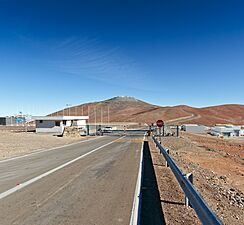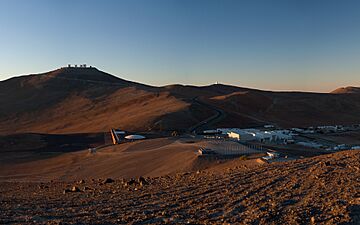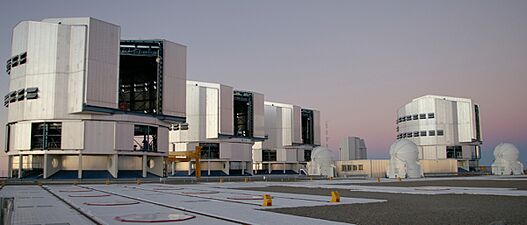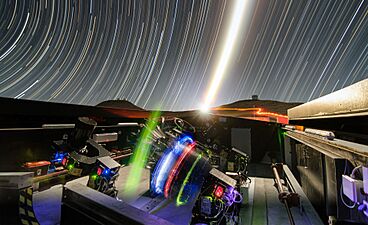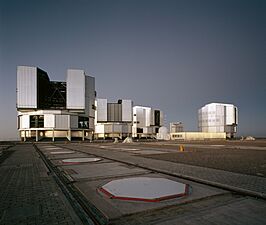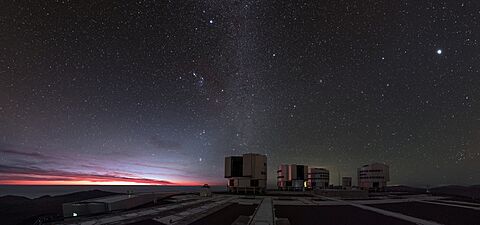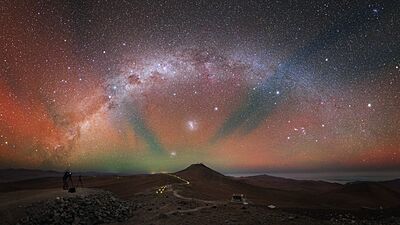Paranal Observatory facts for kids
Quick facts for kids Paranal Observatory |
|||||||||||||
|---|---|---|---|---|---|---|---|---|---|---|---|---|---|
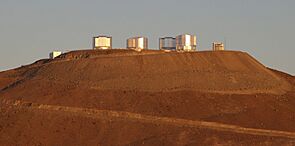
Cerro Paranal is the main mountain where the VLT (four units) and VST (right) are located.
|
|||||||||||||
| Organization | European Southern Observatory | ||||||||||||
| Location | Cerro Paranal, Chile | ||||||||||||
|
Coordinates
|
24°37′38″S 70°24′15″W / 24.62722°S 70.40417°W
|
||||||||||||
| Altitude | 2,635 metres (8,645 ft) | ||||||||||||
|
|||||||||||||
The Paranal Observatory is a special place where scientists study the stars and galaxies. It is run by the European Southern Observatory (ESO). This amazing observatory is found in the Atacama Desert in northern Chile.
It sits on top of a mountain called Cerro Paranal, which is 2,635 meters (about 8,645 feet) high. This makes it a great spot for looking into space. Paranal is one of the biggest observatories in the Southern Hemisphere. It uses powerful telescopes to collect light from far-off objects.
The main telescope here is called the Very Large Telescope (VLT). It is actually made of four huge telescopes working together. Each of these telescopes has a mirror that is 8.2 meters (about 27 feet) wide. They can even combine their light to see things in incredible detail.
The observatory also has other telescopes. These include four smaller auxiliary telescopes. There are also two survey telescopes, VISTA and the VLT Survey Telescope. These are designed to take wide pictures of the sky. Two groups of even smaller telescopes, NGTS and SPECULOOS, search for planets outside our solar system.
Two important new facilities are being built nearby. The southern part of the Cherenkov Telescope Array gamma-ray telescope is located 10 km south-east of Paranal. Also, ESO's future Extremely Large Telescope (ELT) is being built on Cerro Armazones, 20 km east of Paranal. The ELT will share some of Paranal's base facilities.
Contents
Exploring the Telescopes
A Bird's-Eye View
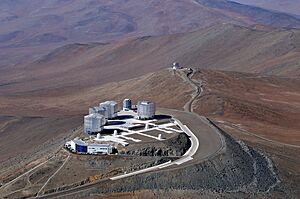
Imagine looking down from above the Paranal Observatory. You would clearly see the four big units of the VLT. Next to them are four smaller, dome-shaped auxiliary telescopes. The VST is right beside the VLT units. You can also spot VISTA on another peak, about 1,500 meters away.
The Very Large Telescope (VLT)
The Very Large Telescope (VLT) is a group of four powerful telescopes. Each telescope has a main mirror that is 8.2 meters wide. They can see both visible light and infrared light. This allows scientists to study many different kinds of objects in space.
Sometimes, these four main telescopes work together with four smaller auxiliary telescopes. They combine their light to create a super-sharp image. This method is called optical interferometry. It helps astronomers see very fine details. The VLT also uses special technology called adaptive optics. This helps correct the blurring effects of Earth's atmosphere. It makes the images from space much clearer.
VISTA Survey Telescope
VISTA stands for Visible & Infrared Survey Telescope for Astronomy. It is a 4.0-meter telescope with a very wide view. VISTA is excellent at taking large pictures of the sky, especially in infrared light. This helps scientists find new objects and map huge areas of space.
This telescope was built by a group of 18 universities from the United Kingdom. They gave it to the ESO in December 2009. VISTA works closely with the VLT to explore the universe.
VLT Survey Telescope (VST)
The VLT Survey Telescope (VST) is another important telescope at Paranal. It has a 2.6-meter mirror and a wide-field camera. The VST helps the four Very Large Telescopes by surveying large parts of the sky. It finds interesting areas for the VLT to study in more detail.
Next-Generation Transit Survey (NGTS)
The Next-Generation Transit Survey (NGTS) is a special facility for finding exoplanets. Exoplanets are planets that orbit stars other than our Sun. NGTS is located a few kilometers from the main observatory peak. It uses an array of twelve smaller, robotic telescopes, each 0.2 meters wide.
These telescopes have a very wide view of the sky. They look for tiny dips in a star's brightness. This dip happens when a planet passes in front of its star, blocking some of its light. This method is called transit photometry. NGTS aims to find many planets similar in size to Earth or Neptune. Science operations for NGTS began in early 2015.
SPECULOOS Southern Observatory (SSO)
The SPECULOOS Southern Observatory (SSO) is another facility dedicated to finding exoplanets. It has four telescopes named Europa, Io, Callisto, and Ganymede. These names come from the moons of Jupiter! The ESO hosts these 1-meter telescopes.
This project focuses on finding exoplanets around very cool, dim stars called ultracool dwarfs and brown dwarfs. These telescopes are located next to the NGTS facility. The project builds on the success of the TRAPPIST telescope.
Life at the Observatory
Besides the telescopes and control rooms, Paranal has a special building called the Residencia. This building provides a comfortable place for staff and visitors to stay. It is located 200 meters lower than the telescopes and about 3 km away.
The Residencia is built partly into the mountain itself. Its concrete walls are colored to blend in with the natural landscape. It includes a gym, a swimming pool, a restaurant, and two gardens. It's a unique place designed to help people relax after a long day of studying the stars.
Images for kids
-
The NGTS with the VLT and VISTA in the background
See also
- Very Large Telescope
- List of largest optical reflecting telescopes
- List of astronomical observatories
- List of highest astronomical observatories
- Other observatories in Chile:
- Llano de Chajnantor Observatory
- Cerro Armazones Observatory
- Extremely Large Telescope
- La Silla Observatory
- Cerro Tololo Inter-American Observatory
- European Northern Observatory
- VVV Survey


